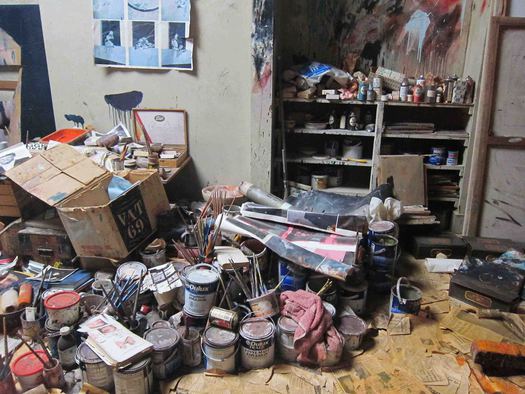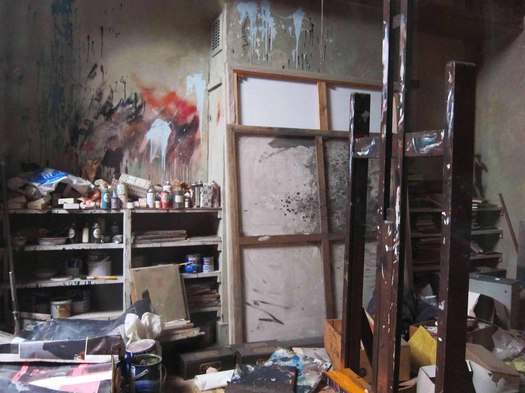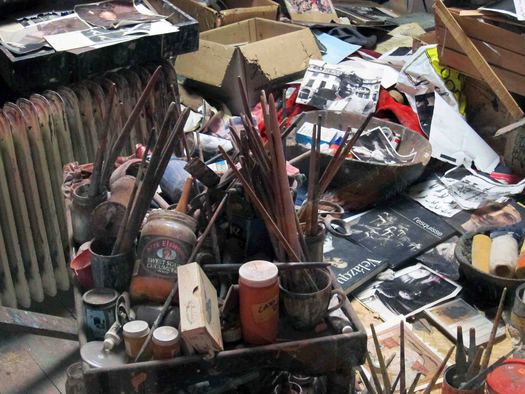
Used bookstore, Nice, France, 2012
1. Dysfunctional clutter
Anything can become clutter, including books. I took this picture a few weeks ago in a used bookstore in Nice, in the south of France. I was looking for old French paperbacks and I had seen one or two possibilities in some rotating racks on the street, so I went inside. In the cavernous space, more like some mad entropic warehouse than a shop, the books rose from the floor in great looming cliffs of paper, the volumes crushed against each other like tectonic plates shattered into thousands of fragments. Near the cash desk in the gloom at the back, an overloaded shelf was leaning so far sideways it threatened to collapse and bury alive an unwary book lover under an avalanche of printed matter. Apart from me, though, there weren’t any visitors.
I could see the kinds of book I was after, but they were inaccessible, locked in place by the great weight of paper above. The owner approached me and I told him what I was looking for. “Come back tomorrow,” he said. I paid for a couple of books and left. The following afternoon, taking him at his word, I returned. The place was empty again. He didn’t look too pleased to see me. He hadn’t moved anything since the day before, or found any paperbacks. I would just have to look for myself. Cautiously, I began to move a few volumes in a stack that appeared promising. The owner became agitated. “We’re closed,” he said. “You go now.” Perhaps I should have given up at once and left him to his chaos, but I persisted, reminding him he’d told me to come back today. “Come back tomorrow,” he said.
I called it a day and left. This impenetrable grotto of print didn’t look remotely like a functioning shop and I found it hard to believe after two brush-offs that the owner cared much about selling anything. Most of his stock had been reduced to clutter and rendered completely inaccessible, and any kind of persistence, let alone disturbing the precarious piles, was clearly unwelcome. Every item had its position in the edifice of paper and there it would stay. It was as though unbridled directionless hoarding rather than selling to book seekers had become the true purpose of the store.
The shop was an extreme public example of the condition of compulsive hoarding that afflicts many of us now. Clutter is the stubborn, shameful, wanted-but-not-wanted residue of our affluence. It thickens around us and clogs up our living spaces. We paid for these things, or perhaps received them as gifts, so it can be hard to throw them out. We preserve them, jam them on to shelves, push them into corners, cram them into cupboards, and stash them out of sight under the bed. There is often a designated zone — a room, basement, attic or garage — where these inert, decommissioned objects accumulate en masse. In my home, this storage depot is the loft, which houses 30 or more years’ worth of accreted domestic clutter, some of it wanted (the personal things) but much of it no longer used or even remembered, yet somehow too good, too potentially useful again at some once vaguely imagined moment in the future that will never actually arrive, to let go. Each year the cargo of loft clutter becomes more swollen, unbreachable and pointless. (And I’m not even talking here about the seemingly ineradicable drifts of day-to-day clutter in the house below.)
But enough is enough. Over the summer, little by little, we’ve been clearing out the loft. Sorting through the clutter, deciding what to do with it, and breaking it down into categories has taken many days of work: things that are genuinely worth keeping; things for other people to take if they can find a use for them; things for recycling; things for the charity shop; things with no conceivable second life that will have to go into the trash. How good it feels to shed the burden and give proper order to what remains. Can we stick to our post-clearout resolution never to let clutter on this scale (a necessary qualification since there is always clutter) overrun us again?
Clutter and design are inseparable as concepts because clutter is the negation of design. The items that compose a heap of clutter might be well designed in themselves, but their ragged disposition strips them of beauty and purpose. Jammed against other objects that are often entirely different in provenance, genre, purpose or style, they lose their particularity and aura, as well as their function, and become dead matter. There is a fine line, though, between raw, superfluous, life-draining clutter and an intermediary, more exalted kind of clutter, which I have touched on regularly in this blog because I am obsessed with it. Treated as part of a collection, whether in a museum or a junk shop, and put into artful arrangements with other objects, units of clutter can become charged, poetic and strange. Objects that were once someone else’s clutter may carry the potential to acquire new meaning and, under new ownership, become desirable commodities of a different complexion. As I have written in a recent column for Print, even the lowliest trash can be redeemed.
While I was taking a break from the clutter in my loft and looking for old paperbacks in French bookstores, I received a timely email from a graphic design instructor called John McVey. In 1995, an issue of Emigre about writing and design, guest edited by Anne Burdick, included an essay about clutter by Steve Baker, a British academic. “I’ve always thought it was among the best essays Emigre ever ran,” wrote McVey. I thought it was a tremendous essay, too, but it has never been available online and McVey wanted to find a way of publishing it again. With the agreement of Steve Baker and Rudy VanderLans at Emigre, I am pleased to present “'To Go About Noisily': Clutter, Writing and Design” as a PDF (made by McVey), showing the essay’s original page design by Anne Burdick.
2. Clutter and creativity



Reconstruction of Francis Bacon’s studio, Dublin City Art Gallery The Hugh Lane, Dublin, Ireland, 2011
Photographs: Rick Poynor
This essay was originally published in August, 2012.
